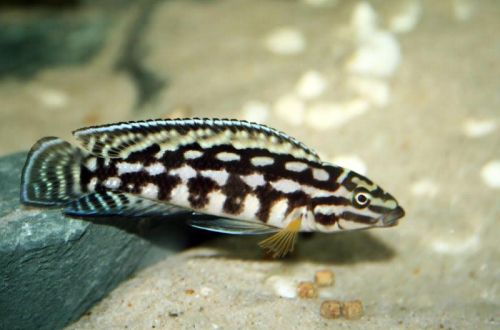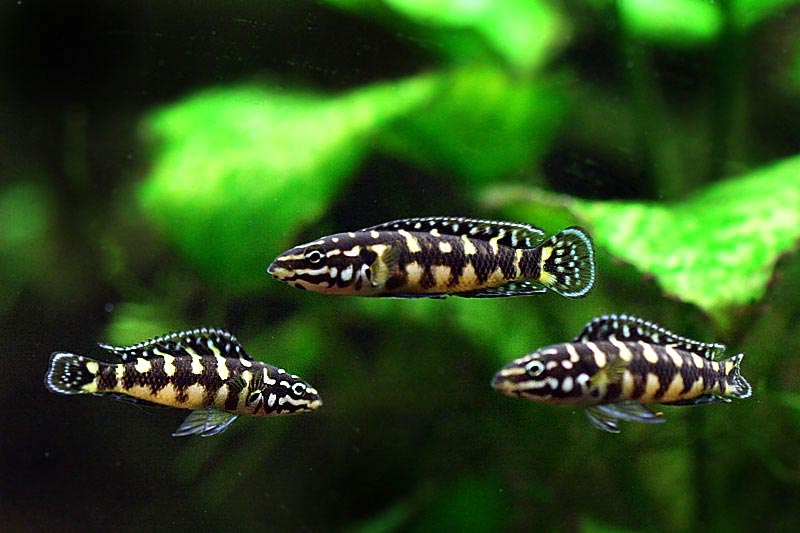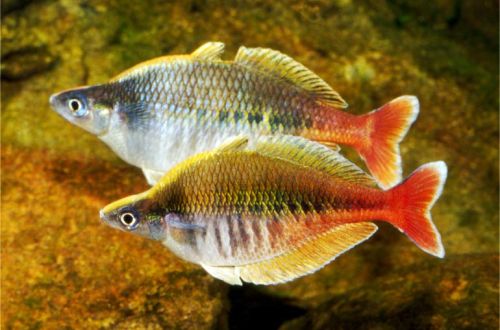
Julidochromis Marliera
Julidochromis Marliera, scientific name Julidochromis marlieri, belongs to the Cichlidae family. A bright mobile fish with unusual intraspecific relationships. As they mature, they can form a male/female pair that persists throughout their lives. Easy to keep and breed, compatible with many species from the same habitat. Due to their behavior, they cannot be recommended for beginner aquarists.

Contents
Habitat
Endemic to Lake Tanganyika in Africa, located between four states. The longest coastline is in Tanzania and the Democratic Republic of the Congo. The fish lives in the northern and southern parts of the island among the rocky shores.
Brief information:
- The volume of the aquarium – from 100 liters.
- Temperature – 23-27°C
- Value pH — 7.5–9.5
- Water hardness – medium to high hardness (10-25 dGH)
- Substrate type – sandy
- Lighting – moderate
- Brackish water – no
- Water movement – weak, moderate
- The size of the fish is about 15 cm.
- Nutrition – high-protein feed with herbal supplements
- Temperament – conditionally peaceful in relation to other species
- Keeping in a male/female pair
Description

Adult individuals reach a length of about 15 cm. Sexual dimorphism is weakly expressed. Outwardly, it is very difficult to distinguish between a male and a female to an inexperienced eye. The body pattern consists of rows of large white spots on a dark background. There is a blue border on the fin and tail.
Food
The diet should consist of frozen meat or live foods with herbal supplements. For example, bloodworm, brine shrimp together with spirulina flakes or pieces of nori seaweed. Dry sinking foods can be used as sources of vitamins and microelements, but they should not be the basis of food.
Maintenance and care, arrangement of the aquarium
The optimal size of the aquarium for a pair of Julidochromis Marliera starts from 100 liters. Design should mimic the natural environment. It, in turn, is quite simple. Sandy substrate and heaps of stones and rocks, from which caves, grottoes, gorges are formed.
Maintaining stable water conditions with suitable hydrochemical conditions is key to successful management. At a minimum, you will need to install a productive filtration system, as well as regularly clean the aquarium of organic waste and replace part of the water (15–20% of the volume) with fresh water weekly.
Behavior and Compatibility
Territorial view, in a small aquarium will compete with relatives for a plot at the bottom. Sometimes rivalry can be very fierce and lead to the death of a weaker individual. In a large volume, it is permissible to contain a group of Julidochromis Marlier. It is worth noting that the fish, as they grow older, form a pair that persists throughout their lives. Calmly relate to representatives of other species.
Breeding / breeding
Breeding of this species is quite simple, provided that there is a formed pair. It can be obtained by purchasing a flock of young Julidochromis, and in a year and a half, a suitable male and female will find a friend. Another, more simple way, is to find a ready-made pair of adult fish.
It must be remembered that it is not enough to add a male and a female together, especially if they did not grow up together in order to get offspring. Most likely, the fish will not converge, and in the worst case, the female will die.
In favorable conditions, the couple chooses a reliable shelter and lays eggs there, usually no more than 100 pieces. After fertilization, the female remains in the shelter to protect the masonry, and the male guards the approaches to it. The incubation period lasts about 3 days. Parental care continues until the fry reach a length of 2 cm. Then adult fish can give birth to new offspring.
Fish diseases
The main cause of most diseases of cichlids from Lake Tanganyika is unsuitable housing conditions and poor quality food, which often leads to such a disease as African bloat. If the first symptoms are detected, you should check the water parameters and the presence of high concentrations of hazardous substances (ammonia, nitrites, nitrates, etc.), if necessary, bring all indicators back to normal and only then proceed with treatment. Read more about symptoms and treatments in the Aquarium Fish Diseases section.





